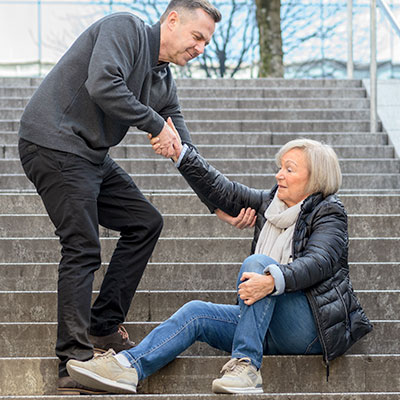Premises liability claims can be some of the most difficult cases to prove. Unfortunately, such incidents can result in a range of severe injuries, such as permanent back pain, fractured ankles, dislocated knees, broken wrists, and even paralysis and traumatic brain injuries.
Before joining the Allen & Allen team, I defended large corporations against premises liability claims. These claims were filed by individuals who were severely injured as a result of slipping on spilled liquid, slipping on mopped floors, tripping over improperly stored boxes and grocery carts, and being run into by store employees with stock carts. I learned all the defenses to these claims that make it very difficult for plaintiffs to prevail without good legal representation.
What is a premises liability case?
When we refer to premises liability, we are mostly talking about liability that is imposed on businesses for failing to protect their customers from hazards on their property. Property owners owe different duties of care to social guests and nearly no duty to keep property safe for trespassers.
Businesses owe their customers a duty to keep their premises in a reasonably safe condition for the use of their patrons. A store owner must either fix any unsafe conditions or warn people of any unsafe conditions that the owner is, or should be, aware of. A property owner can be made aware of an unsafe condition when a hazard is seen by or reported to an employee, which is called being put on notice. Otherwise, a property owner can be put on “constructive notice,” which occurs when an unsafe hazard is present for so long that a reasonable property owner should have been aware of it.
Filing a claim against a business owner
It is important to realize that the injured person ultimately has the burden of proving that the business failed to take reasonable care to protect them. This means the claimant must gather evidence of how they were injured and how the property owner could have acted differently to prevent the unsafe condition. Under Virginia law, the claimant has the burden of proving that the owner knew or should have known of the hazard. So, the injured person has to have evidence that the business was either on notice or had constructive notice of the unsafe condition.
In an incident where a store employee mops the floor and then walks away without putting out a wet floor sign, notice is clear. A store employee created the hazardous slippery condition and in that way the store is aware of it. In many other cases, notice is much more difficult to prove. For instance, take a situation where a person slips on a grape at the grocery store and is injured. In order to have a claim against the grocery store, that person must either find evidence that the grocery store was aware of the slippery grape and failed to clean it up or put out a warning, or the injured person must have evidence that the grape was on the floor for so long that the grocery store should have known the grape was there.
Absent an employee admitting to seeing the grape and not taking action, it is unlikely that the victim will have any evidence that the grocery store actually knew the grape was there. So, in most instances, the victim will have to have evidence that the grocery store was on constructive notice.
Steps in a premises liability lawsuit against a business owner
Proving how long a grape or debris or water or any other unsafe slippery or sticky condition was on the floor before an incident can be very difficult. It is often impossible without video evidence or eyewitness statements from another customer. The injured person will not know how the grape got there or how long it had been there. If an injured person knew it was there, it is very unlikely that person would have slipped on it in the first place. Without any evidence, all we can do is speculate. The grape might have been there all day, but one can just as easily assume that the last customer to walk by dropped it just before the fall. If that is the case, then the store could not have had enough time to become aware of the grape no matter how stringent their store inspection policies are. In such a case, the claimant will fail to prove notice and cannot win their premises liability case.
Another hurdle to success in a premises liability case is that the property owner will often accuse the person who fell of failing to act reasonably. A person who fails to see an open and obvious unsafe condition and is injured by that hazard cannot recover from the property owner. So, returning to our grape in the store, the grocery store will typically argue that any reasonable person who is watching where they are going would have seen the large bright green grape smashed on the white linoleum floor and would have walked around it. Blaming the victim can be a very powerful defense in a premises liability case.
This dynamic can sometimes create a Catch 22 where the claimant must show that the hazard was something the store should have been aware of and failed to clean up, while avoiding a defense that the condition should have been obvious to a customer who was watching where they were going. Avoiding this, along with other pitfalls in premises liability cases, often requires an experienced evaluation of the facts of the case and immediate action to gather evidence.
Gather evidence as soon as possible in a lawsuit against a business owner
If you or a loved one have been severely injured as a result of a slip and fall or trip and fall, have had merchandise fall on you, or have been injured as a result of some other event at another person’s property, I encourage you to hire an attorney as soon as possible. It is imperative that a professional get involved early to secure evidence, obtain video evidence, conduct witness interviews, collect incident reports, and take pictures as soon as possible to prepare for meeting the claimant’s burden of proof in a premises liability case.
About The Author: Rob Reed is an experienced personal injury attorney with the law firm of Allen & Allen. He works out of the Richmond office. Rob has devoted his practice to helping victims of serious accidents and their families in personal injury cases.




